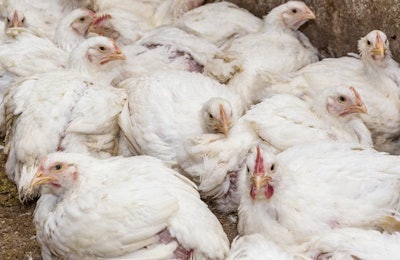
Latest figures from the poultry industry association in the United Kingdom point to an annual reduction in the use of antibiotics by the sector of almost 39.4 percent.
Since its Antibiotic Stewardship scheme began in 2012, members of the British Poultry Council (BPC) have achieved an 82 percent reduction in the total use of antibiotics, and the use of fluoroquinolones — which are among the Critically Important Antibiotics for human health — is down by 91 percent, and used only as a last resort.
These reductions in antibiotic use by the sector have been welcomed by the country’s animal health agencies.
UK Chief Veterinary Officer Christine Middlemiss described the achievements as “remarkable,” crediting producers with combining a review of farm biosecurity and disease management practices with the prudent use of antibiotics.
“Impressive reductions” were attributed by the Professor Peter Borriello, chief executive officer of the Veterinary Medicines Directive, to will, strong leadership and teamwork.
Despite the reductions in antibiotic use, the British poultry meat sector continues to deliver excellent bird health and welfare, said BPC Chairman John Reed. However, he stressed the need to retain these drugs for use when they are required.
“Our farmers and veterinarians need antibiotics in their toolbox to preserve the health and welfare of our birds,” said Reed. “Responsible use of antibiotics is about so much more than reduction targets. Zero use is neither ethical nor sustainable as it goes against farmers’ duty to alleviate pain and suffering.”
In 2017, the British poultry meat sector used a total of 14.38 metric tons of antibiotics (in terms of active ingredient), according to the BPC Antibiotic Stewardship Report 2018. This level is 39.4 percent below the 2016 figure (23.72 metric tons), and 82 percent down from that of 2012.
In 2012, the poultry sector used 9.7 percent of the total antibiotics licensed for use in food-producing animals. This compares with 21 percent in 2012.
Furthermore, the industry has already achieved the government-approved sector-specific targets developed last year by the Responsible Use of Medicines in Agriculture Alliance (RUMA) for chickens (25mg per pcu*), and turkeys (50 mg per pcu). The actual levels recorded for 2017 were 9.85 and 45.28mg per pcu, respectively. The equivalent figure for ducks was 3.25mg per pcu.
On Critically Important Antibiotics (CIAs), the BPC Antibiotic Stewardship scheme follows the guidelines set out by the World Health Organization (WHO). In 2012, the UK poultry meat sector stopped using third- and fourth-generation cephalosporins, and ceased administering polymyxins (including colistin) in 2016.
In its report, the BPC stressed that the strict adherence to regulations on drug withdrawal mean that there are no residues in the meat, even if antibiotics have been administered to treat the bird during its life.
There are a number of strategies to reduce antibiotic usage. Among the latest developments to have emerged is quorum drenching with probiotics.
*A measure of antibiotic use, pcu or Population Corrected Units, take into account the animal population, as well as the estimated weight of each animal at the time of treatment.















